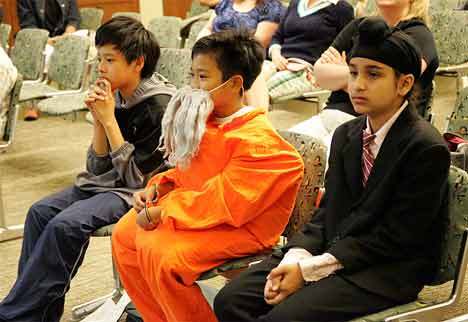The jury was not in session too long, but as they filed out of the jury room at the Tukwila Courthouse, only a few shot glances at the defendant, Herschel C. Lyon.
Lyon was accused of the murder of Sam Steelhead and though he testified that the attack on steelhead was not premeditated, but simply because he was hungry, the cross examination had been tough and the prosecution was making a strong case.
Finally, the verdict was read: Guilty.
As cheers went up on the side of the prosecution, Lyon (actually Nicolas Morales, 12, in an orange jumpsuit, beard and handcuffs) collapsed in a heap on the courtroom floor.
He was then taken downstairs to face the music.
“I got fingerprinted and put in a jail cell,” Morales said after the June 2 event.
All in a day’s work for a … fifth grade class from Ridgewood Elementary School.
At least it was for Patti Smith’s class when they had an opportunity to visit the Tukwila courtroom of Judge Kimberly Walden, whose daughter Peyton Chick is a student in Smith’s class.
For more than a month beforehand, the class separated into groups: prosecution, defense and the judges/baliff/jury; and prepared for the case of State of Washington v. Herschel C. Lyon, using the knowledge they’d learned through the year about the branches of government, as well as persuasive writing to prosecute the entire case and sit on the jury.
The case is available online from Washington Courts as a teaching resource and the kids prepared on each side.
Chick, 10, was part of the prosecution and said the case was a lot of fun.
“It was about kids just trying to be adults,” she said. “You know kids, they don’t have jobs.”
Chick and her fellow prosecutors tried to show that Lyon’s decision to eat the fish (Sam Steelhead) was not only unnecessary (Lyon, in his padded orange jump suit, was a bit fat for a sea lion) and to show off, but also premeditated in that he swam all the way up from California to grab a snack.
But on the defense side, they had different ideas.
“He wasn’t guilty, but he really needed to eat the fish,” said Eyob Tefera, 11, an attorney on the defense team.
“He did what came naturally,” agreed fellow defense team member Allen Hamby, 11.
Each side also created slide shows and graphs and other visual aids to help make their argument, adding math skills to the mix by figuring what a sea lion should eat and comparing that to Herschel’s diet.
In the jury room, things were a little tense as initially there was a split.
“We were kind of debating about if he was guilty or not,” said jury member Brooks Maxwell, 10.
In the end, Lyon’s weight problem (really a pillow stuffed in the slender Morales’s jump suit) convinced the two holdouts on the jury that eating Sam was not, in fact, a necessity.
“He was just eating that second fish to show off,” Maxwell said.
More than anything, however, the kids got a hands-on look at how the justice system works, something that was not lost on the class.
“It’s a really good learning experience because you learn a lot about the different branches of government,” said Anna Bolton, 10.
“I learned how hard the jury has to listen,” said Becca Lapins, 11.
“I learned that if you really want to win an argument you have to be as persuasive as you can,” said Wilson Tang, 11.
Even Chick, whose mother helped the kids along and then praised them afterward for their professionalism, said she learned some things about how a court works.
“It doesn’t take one person to win a case,” she said. “It takes a lot of people.”
The class also said they learned a lot about the process and understand a lot better the judicial system. Most said they liked the way a jury decides instead of a single person and the way a jury is a random and impartial group.
The judges, Maggie Hagerty and Andrea Ostler, both 11, also said they liked presiding over the court and even had to rule on a series of objections.
“If we really thought it was leading or irrelevant, we said it was,” said Hagerty.
In the end, Lyon may have been sent to the slammer, but the experience is one the students will most likely never forget, Smith said.
“Whenever you have a real-life experience like this they can see how you use all the strategies and skills,” Smith said. She added it was a great way to involve the entire class.
“Kids that normally don’t get engaged got engaged,” she said. “They all felt important and needed.
“This is going to be a life-long learning experience.” Smith said.
More information on the Washington Courts program, including the case of State of Washington V. Herschel C. Lyon can be found at www.courts.wa.gov/education/lessons/?fa=education_lessons.lpelem
Talk to us
Please share your story tips by emailing editor@kentreporter.com.
To share your opinion for publication, submit a letter through our website https://www.kentreporter.com/submit-letter/. Include your name, address and daytime phone number. (We’ll only publish your name and hometown.) Please keep letters to 300 words or less.

